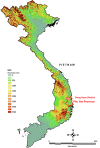Targeting high risk forest goers for malaria elimination: a novel approach for investigating forest malaria to inform program intervention in Vietnam
- PMID: 33059623
- PMCID: PMC7559775
- DOI: 10.1186/s12879-020-05476-8
Targeting high risk forest goers for malaria elimination: a novel approach for investigating forest malaria to inform program intervention in Vietnam
Abstract
Background: Individuals that work and sleep in remote forest and farm locations in the Greater Mekong Subregion continue to remain at high risk of both acquiring and transmitting malaria. These difficult-to-access population groups largely fall outside the reach of traditional village-centered interventions, presenting operational challenges for malaria programs. In Vietnam, over 60% of malaria cases are thought to be individuals who sleep in forests or on farms. New malaria elimination strategies are needed in countries where mobile and migrant workers frequently sleep outside of their homes. The aim of this study was to apply targeted surveillance-response based investigative approaches to gather location-specific data on confirmed malaria cases, with an objective to identify associated malaria prevention, treatment and risk behaviors of individuals sleeping in remote forest and farms sites in Vietnam.
Methods: A cross-sectional study using novel targeted reactive investigative approaches at remote area sleeping sites was conducted in three mountainous communes in Phu Yen province in 2016. Index cases were defined as individuals routinely sleeping in forests or farms who had tested positive for malaria. Index cases and non-infected neighbors from forest and farm huts within 500 m of the established sleeping locations of index cases were interviewed at their remote-area sleeping sites.
Results: A total of 307 participants, 110 index cases and 197 neighbors, were enrolled. Among 93 participants who slept in the forest, index cases were more likely to make > 5 trips to the forest per year (prevalence odds ratio (POR) 7.41, 95% confidence interval (CI) 2.66-20.63), sleep in huts without walls (POR 44.00, 95% CI 13.05-148.33), sleep without mosquito nets (POR 2.95, 95% CI 1.26-6.92), and work after dark (POR 5.48, 95% CI 1.84-16.35). Of the 204 farm-based respondents, a significantly higher proportion of index cases were involved in non-farming activities (logging) (POR 2.74, 95% CI 1.27-5.91).
Conclusion: Investigative approaches employed in this study allowed for the effective recruitment and characterization of high-priority individuals frequently sleeping in remote forest and farm locations, providing relevant population and site-specific data that decision makers can use to design and implement targeted interventions to support malaria elimination.
Keywords: Forest malaria; Greater Mekong subregion, Vietnam; Malaria elimination; Mobile and migrant populations.
Conflict of interest statement
The authors declare that they have no competing interest.
Figures


Similar articles
-
Results from a malaria indicator survey highlight the importance of routine data capture in high-risk forest and farm transmission sites in Vietnam to tailor location-specific malaria elimination interventions.PLoS One. 2021 Apr 16;16(4):e0250045. doi: 10.1371/journal.pone.0250045. eCollection 2021. PLoS One. 2021. PMID: 33861798 Free PMC article.
-
Risk factor assessment for clinical malaria among forest-goers in a pre-elimination setting in Phu Yen Province, Vietnam.Malar J. 2019 Dec 20;18(1):435. doi: 10.1186/s12936-019-3068-4. Malar J. 2019. PMID: 31861988 Free PMC article.
-
Mosquito Net Ownership, Utilization, and Preferences among Mobile and Migrant Populations Sleeping in Forests and Farms in Central Vietnam: A Cross-Sectional Study.Am J Trop Med Hyg. 2021 Apr 5;104(5):1917-1924. doi: 10.4269/ajtmh.20-0711. Am J Trop Med Hyg. 2021. PMID: 33819169 Free PMC article.
-
How can interventions that target forest-goers be tailored to accelerate malaria elimination in the Greater Mekong Subregion? A systematic review of the qualitative literature.Malar J. 2019 Feb 1;18(1):32. doi: 10.1186/s12936-019-2666-5. Malar J. 2019. PMID: 30709399 Free PMC article.
-
Malaria elimination challenges in countries approaching the last mile: a discussion among regional stakeholders.Malar J. 2024 Dec 26;23(1):401. doi: 10.1186/s12936-024-05215-3. Malar J. 2024. PMID: 39722002 Free PMC article. Review.
Cited by
-
Intermittent preventive treatment for forest goers by forest malaria workers: an observational study on a key intervention for malaria elimination in Cambodia.Lancet Reg Health West Pac. 2024 May 17;47:101093. doi: 10.1016/j.lanwpc.2024.101093. eCollection 2024 Jun. Lancet Reg Health West Pac. 2024. PMID: 38799614 Free PMC article.
-
Asymptomatic malaria infection at the China-Vietnam border: Knowledge and implications for the cross-border migrant population during the COVID-19 pandemic.Travel Med Infect Dis. 2022 May-Jun;47:102307. doi: 10.1016/j.tmaid.2022.102307. Epub 2022 Mar 8. Travel Med Infect Dis. 2022. PMID: 35276354 Free PMC article.
-
Entomological survey in two communes with residual malaria transmission in Gia Lai Province in the central highlands of Vietnam.Malar J. 2021 Oct 16;20(1):403. doi: 10.1186/s12936-021-03941-6. Malar J. 2021. PMID: 34656112 Free PMC article.
-
The effect of novel mosquito bite prevention tools on Anopheles minimus landing and key secondary endpoints: semi-field evaluations in Thailand.Malar J. 2024 Dec 18;23(1):387. doi: 10.1186/s12936-024-05188-3. Malar J. 2024. PMID: 39695591 Free PMC article.
-
Effect of out-of-village working activities on recent malaria exposure in the Peruvian Amazon using parametric g-formula.Sci Rep. 2022 Nov 9;12(1):19144. doi: 10.1038/s41598-022-23528-8. Sci Rep. 2022. PMID: 36351988 Free PMC article.
References
-
- WHO . World Malaria report. Geneva: World Health Organization; 2019.
-
- WHO . A framework for malaria elimination. Geneva: World Health Organization; 2017.
-
- Dondorp AM, Smithuis FM, Woodrow C, Lv S. How to contain Artemisinin- and multidrug-resistant falciparum malaria. Trends Parasitol. 2017;33(5):353–363. - PubMed
-
- WHO . Eliminating Malaria in the Greater Mekong Subregion. United to end a deadly disease. Geneva: World Health Organization; 2016.
-
- WHO . Strategy for Malaria elimination in the Greater Mekong Subregion (2015–2030) Geneva: World Health Organization; 2015.
MeSH terms
Grants and funding
LinkOut - more resources
Full Text Sources
Medical

